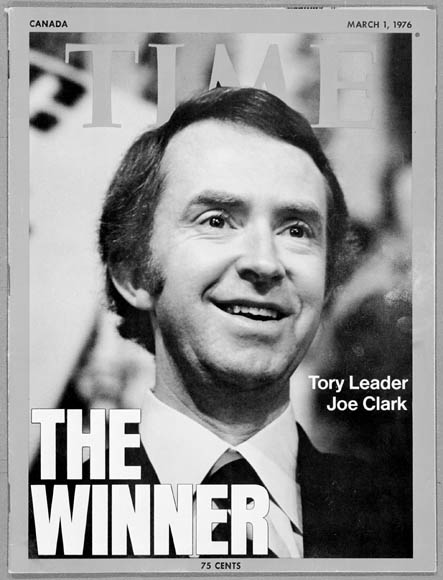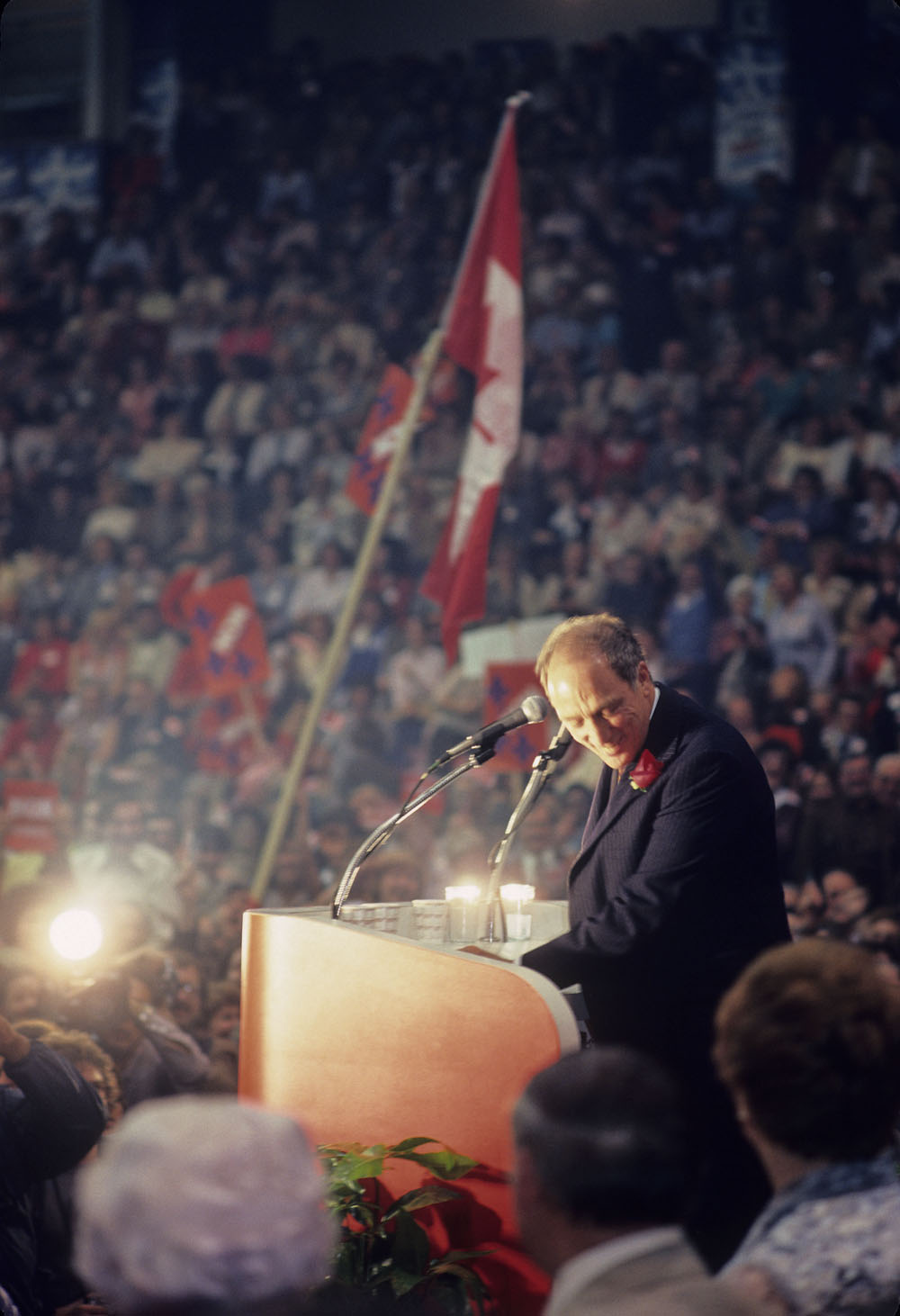Chapter 9. Cold War Canada, 1945-1991
9.11 Quebec and the ROC

In the aftermath of the October Crisis, neither the nation nor the province of Quebec turned against the Liberals — not immediately. Trudeau, Bourassa, and especially Drapeau enjoyed a significant bump in popularity and confidence in the months immediately after the crisis. It did not last. In 1972, the Trudeau government was reduced to a minority and the NDP — led by David Lewis, a vocal critic of the emergency measures — held the balance of power. Remarkably, it was only in Quebec that the federal Liberals did especially well, losing out to the Tories in every other province. The short-term effects for the Parti Québécois (PQ) were also disappointing: from seven seats in the National Assembly in 1970, they fell to six in 1973.
Canadian politics in the post-1970 years involved visibly addressing Quebec’s issues in a variety of ways. Canada joined the Organisation international de la Francophonie (aka: La Francophonie), an international forum of nations (many of them former colonies of France) where the use of the French language was widespread. The Royal Commission on Bilingualism and Biculturalism reported out in 1969, and there was a new urgency after October 1970 to implement some of its recommendations. Material changes included more French language instruction in schools and a reversal of decades-old policies in Ontario, New Brunswick, and Manitoba that minimized the rights of francophones to instruction in their first language. Access to services in French in the courts was also addressed, and New Brunswick took steps to become officially bilingual. While these initiatives were seen by some in Quebec as a distraction from the substantive issues of power relations between Ottawa and the province, the changes were also decried by many in English Canada as evidence that Ottawa was “shoving French down our throats.”[1] This anglophone francophobia was to cost the Liberals dearly at the polls in the 1970s.
Efforts to reform the constitutional relationship between Quebec and the rest of Canada, moreover, continued to flounder. Premier Bourassa’s efforts to negotiate better terms for Quebec consistently failed. The Victoria Charter (1971) held out the prospect of a veto power for Quebec but it was rejected at the last minute by the premier because he feared a nationaliste protest. His inability to accomplish any meaningful change in this field contributed in large measure to the success of Lévesque and the pequistes in the 1976 election.
The Pequistes in Office
In the 1973 election, the Union Nationale was effectively wiped out. It failed to elect a single candidate out of a full slate of 110. The PQ, with only six seats, therefore, was the Official Opposition, squaring off against Bourassa’s 102 Members of the National Assembly (MNAs). The three years that followed would see Lévesque reposition himself and his party as more than a movement of constitutional change. This was helped by Bourassa’s physical awkwardness and his stilted speaking style and the cascade of scandals that embroiled the government. The 1976 Summer Olympics were held in Montreal and, despite Mayor Drapeau’s promise that “The Olympics can no more lose money than a man can have a baby,” it ran up a $1.5 billion debt. (Aislin responded with a cartoon showing a very pregnant Drapeau.) The Olympic Stadium — the “Big O” — incurred huge overruns and was incomplete when the games commenced. The credibility of the Liberals was now so low that Lévesque could campaign less on separatism and more on the need for good government.

For Canadians in what was becoming known as the Rest Of Canada (ROC), the election of the PQ on 15 November 1976 signalled the end of Confederation. The combination of terrorist attacks in the 1960s and early 1970s, government misspending, a stagnating local (and global) economy, and fear of what the PQ might accomplish constitutionally contributed to a significant out-migration from Quebec of individuals, families, and households. It is reckoned that 99,000 people left the province, turning whole swaths of western Montreal from neighbourhoods where English dominated into areas in which French was the principal language.[2] Whole corporations exited as well. Montreal was, historically, the centre of banking, insurance, and finance, a position that was being increasingly challenged by Toronto. In the decade after the PQ election, many of these firms relocated their head offices from Montreal to Toronto and, more dramatically, to Calgary. The most prominent of these moves was made by Sun Life Financial, one of the largest employers in Montreal and almost certainly the largest employer of anglophones. Following the PQ government’s introduction of the Charter of the French Language (aka: Bill 101), which established the primacy of French in all aspects of life — from street signage to restaurant menus — and protected the rights of unilingual francophone employees against discrimination, Sun Life made a very public show of its displeasure and then left. Montreal’s loss may have been Toronto’s gain (the two quickly swapped places as the nation’s largest cities) but there was a strong sense that the exodus, as it was called, bode ill for Canada as a whole.
Within Quebec and the PQ there were many who hoped for precisely that outcome. As promised during the 1976 campaign, Lévesque began working toward a referendum on Quebec’s place in Confederation. The first step involved reforming electoral laws so as to permit for a referendum of any kind. The second, was to settle on a question. This became a consuming part of the process, as federalists in Quebec and the ROC mobilized their pitch for continuing with the status quo. Within the PQ, there were elements calling for a direct and decisive approach to the question of sovereignty, while others preferred a gradualist approach (étapisme). Pierre Trudeau’s loss of power in the 1979 election introduced a new player in the game, Prime Minister Joseph “Joe” Clark (b. 1939), elected to lead a minority Conservative government in which western Canadian MPs were a powerful force. For the separatists, this looked like a positive sign. Moreover, Trudeau — who might have posed a greater threat in Ottawa than the less-experienced Clark — had announced his retirement from politics. Clark’s government, however, stumbled and fell in a non-confidence vote. The resultant election drew Trudeau back into the role of Liberal leader (a position he had never fully vacated) and, once back in office with a fresh majority, into the fray against Lévesque.
Joe Clark and the Iranian Hostage Crisis
Trudeau had his hostage crisis. Joe Clark had his.

Joe Clark’s image was being diminished as soon as he moved into the public spotlight at 24 Sussex Drive. He was seen (and depicted) as physically awkward and socially unsophisticated. He was and remains the youngest person ever to become Prime Minister (the Trudeaus, père et fils, came to office 9 and 4 years older, respectively) and so could be forgiven for needing time to adjust. Certainly, time has demonstrated his abilities, but in 1979 to 1980, the public could hardly imagine the extent to which the 39-year-old Clark was prepared to endorse and shepherd along a successful international subterfuge.
In February 1979, the Shah of Iran, Mohammad Reza Pahlavi, was overthrown. A few months later, he departed for the United States for medical treatment. The long history of American support for the Shah’s brutal regime and the offer of refuge for Pahlavi greatly angered Iranian revolutionaries. On 4 November 1979, a group of Iranian students and activists, including Islamic fundamentalists who wished to end the Westernization and secularization of Iran, invaded the American embassy in Tehran and seized 66 embassy employees. The women and African-Americans were soon released, leaving 53 white men as hostages. Negotiations failed to free them, and in April 1980, a rescue attempt fell through when the United States aircraft sent to transport them crashed.
Six of the American embassy staff escaped the compound before it fell and went into hiding with members of the Canadian embassy. The Canadian Ambassador to Iran, Ken Taylor (1934-2015), arranged to smuggle the Americans out of the country with Canadian passports issued under a special order by the Clark government. The Canadian Caper was ultimately successful; the arrival home of the American hostages in January produced a burst of pro-Canadian feeling south of the border.
The fanfare came too late to save two regimes. The fate of Jimmy Carter’s presidency had been settled in the November 1979 elections, but Joe Clark’s administration still had hopes of recovering from a non-confidence vote. These ambitions would be dashed in the February 1980 general election.[3]
The Referendum
On 20 May 1980, nearly 86% of Quebec voters went to the polls to vote in the referendum. Meanwhile, the rest of Canada held its breath. As it turned out, federalism caught a break.
Trudeau’s commitment to Quebecers in 1980 of a revamped federalism in which Quebec’s aspirations might be satisfied played well with part of the “Non” vote constituency. Scholars, however, remain divided over whether the 60% who voted against “Sovereignty-Association” were, in fact, voting in favour of the status quo. The question posed in the referendum, over which the PQ had laboured so long, was opaque in its meaning. It was entirely possible for a separatist to conclude that the proposed agreement with Ottawa was too light on sovereignty and too heavy on association. Thus, radical separatistes might vote “Non” so as to prevent anything less than complete separation of Quebec from Canada. Certainly the victory of the “Non” side cannot be entirely explained by enthusiasm for the Liberal position.
The provincial Liberals under Claude Ryan (1925-2004) conducted a poor campaign, and the federal Liberals were hamstrung by legal restrictions on direct involvement (some of which they simply ignored). A turning point came on International Women’s Day when the Quebec Women’s Affairs Minister, Lise Payette (b. 1931) made the first of two speeches in which she critiqued the character of “Yvette,” who, in Quebec schoolbooks, was portrayed as an ideal — a docile, submissive girl. Payette wanted to see these representations removed from the curriculum — a reasonable goal. The next day, however, she publicly accused the “Non” side of being made up of “Yvettes” and she specifically targeted Ryan’s accomplished wife, Madeleine Ryan, as one. Mme. Ryan embraced the title and launched brunch des Yvettes, a rally of women opposed to sovereignty-association.[4] Mme. Ryan’s campaign appealed strongly to Quebec housewives who felt doubly diminished by their social status and Payette’s condescension. Quebec’s vital feminist movement was divided,but now an important block was mobilized in support of “Non.”[5]
The results of the vote were decisive but far from conclusive. It was only the first campaign in what became known as the Neverendum.

The long and short of it
When Trudeau first responded to the election of the PQ in 1976, he indicated that he would be glad to see “clarity” on the constitutional issue in Quebec. Since then, the word “clarity” has figured prominently in discussions on this topic. It did not, however, loom large in the final version of the 1980 referendum question:
The Government of Quebec has made public its proposal to negotiate a new agreement with the rest of Canada, based on the equality of nations; this agreement would enable Quebec to acquire the exclusive power to make its laws, levy its taxes and establish relations abroad — in other words, sovereignty — and at the same time to maintain with Canada an economic association including a common currency; any change in political status resulting from these negotiations will only be implemented with popular approval through another referendum; on these terms, do you give the Government of Quebec the mandate to negotiate the proposed agreement between Quebec and Canada?[6]
Le Government du Québec a fait connaître sa proposition d’en arriver, avec le reste du Canada, à une nouvelle entente fondée sur le principe de l’égalité des peuples ; cette entente permettrait au Québec d’acquérir le pouvoir exclusif de faire ses lois, de percevoir ses impôts et d’établir ses relations extérieures, ce qui est la souveraineté, et, en même temps, de maintenir avec le Canada une association économique comportant l’utilisation de la même monnaie ; aucun changement de statut politique résultant de ces négociations ne sera réalisé sans l’accord de la population lors d’un autre référendum ; en conséquence, accordez-vous au Gouvernement du Québec le mandat de négocier l’entente proposée entre le Québec et le Canada?
Key Points
- Although the Liberals held on to their support in Quebec immediately after the October Crisis, they were in retreat in much of the rest of Canada in the 1970s.
- Efforts to reform the constitution and to improve the status of francophones in Canada were made but were viewed by many in Quebec as too little too late.
- The PQ came to office in an election marked by spending scandals surrounding the 1976 Olympics with the promise of a referendum to decide Quebec’s future in or out of Confederation.
- The four years that followed saw anglophone households, businesses, and corporations vacate Quebec; the collapse of the Trudeau government’s popularity; and further failure to find a way out of the constitutional impasse.
- The referendum on 20 May 1980 produced a 60% “Non” vote which left the door open for further referenda and renewed constitutional talks.
Long Descriptions
Figure 9.46 long description: Two badges from the 1995 Quebec independence referendum. The first is round and reads “Mon non est quebecois,” which translates into English as “My no is Quebecois.” This puns on the French words non and nom, which mean “no” and “name” respectively. It was a slogan that “non” voters used to defend their commitment to Quebec despite wanting to remain part of Canada.
The second badge is rectangular and depicts a blue fleur-de-lis bursting out of an egg that is painted with the Canadian flag. In the wake of the fleur-de-lis is the word “oui,” meaning “yes.” [Return to Figure 9.46]
Media Attributions
- Referendum badges © John Douglas Belshaw is licensed under a CC BY-SA (Attribution ShareAlike) license
- Games of the XXIX Olympiad, 1976 © Library and Archives Canada, Acc. No. 1994-434-254. No known restrictions
- Page couverture de la revue “Time”, édition canadienne du 1er mars, 1976 – Photo de Joe Clark élu chef du parti conservateur © Duncan Cameron, Library and Archives Canada (C-088836). Copyright assigned to Library and Archives Canada by copyright owner Duncan Cameron. No restrictions on use.
- Pierre Trudeau giving speech at “NO” referendum © Robert Cooper, Library and Archives Canada (MIKAN no. 3588019). Copyright Crown. No restrictions on use.
- Michael Hayday, So They Want Us to Learn French: Promoting and Opposing Bilingualism in English-Speaking Canada (Vancouver: University of British Columbia Press, 2015), 4. ↵
- Marc V. Levine, The Reconquest of Montreal: Language Policy and Social Change in a Bilingual City (Philadelphia: Temple University Press, 1991), 120-1. ↵
- Openstax, U.S. History: "Jimmy Carter in the Aftermath of the Storm", https://cnx.org/contents/p7ovuIkl@9.5:n8t1hRY9@7/30-5-Jimmy-Carter-in-the-Aftermath-of-the-Storm. ↵
- Stephanie Godin, “The Yvettes as the Expression of a Federalist Feminism in Quebec,” in Michael D. Behiels and Matthew Hayday, eds., Contemporary Quebec: Selected Readings and Commentaries (Montreal & Kingston: McGill-Queen’s University Press, 2011): 340-4. ↵
- Constance Backhouse and David H. Flaherty, Challenging Times: The Women’s Movement in Canada and the United States (Montreal & Kingston: McGill-Queen’s University Press, 1992), 112-13. ↵
- Canada. Quebec. 1980 Quebec Referendum (announced 20 December 1979). ↵
An agreement to patriate the British North America Act, which included an amending formula, new civil, personal, and language rights, and provisions for regional equalization; achieved agreement from nine provinces and narrowly failed to secure Quebec's approval from Premier Robert Bourassa.
A term used to describe all Canada apart from Quebec; has the advantage of avoiding the idea of dualism (as in English- vs. French-Canada).
The Charter of the French Language, passed into law in 1977 which advanced the provisions of the Official Language Act (Bill 22) of 1974, and which made French Quebec's official language. Bill 101 established the primacy of French in day to day life.
The rescue of six American diplomats during the Iranian Revolution of 1979 to 1980.
The series of referendums dealing with Quebec separatism (or sovereignty-association) and proposed changes to the constitution, beginning in 1980.

